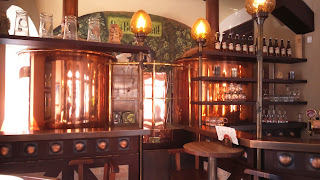 On my recent trip to the Czech Republic, the group I was with was fortunate to visit one of the country’s most respected breweries, namely Bernard, who brew in the small town of Humpolec, which was a short bus ride away from our base in Jihlava. Bernard beers have an excellent reputation, both at home and abroad, and when you read on the company’s website the care taken over the selection of ingredients and the attention to detail in the brewing process, you can understand why.
On my recent trip to the Czech Republic, the group I was with was fortunate to visit one of the country’s most respected breweries, namely Bernard, who brew in the small town of Humpolec, which was a short bus ride away from our base in Jihlava. Bernard beers have an excellent reputation, both at home and abroad, and when you read on the company’s website the care taken over the selection of ingredients and the attention to detail in the brewing process, you can understand why.For example, Bernard malts its own barley in a traditional floor maltings, at Rajhrada near Brno. They select only the highest quality Czech hops, ensuring the perfect balance between aroma and bitterness. They use their own spring water from the Czech-Moravian Highlands, which has the ideal attributes for brewing. They also have their own, unique yeast culture.
On the brewing side the lengthy maturation process is separated from the primary fermentation, with the former being carried out in traditional, horizontal lagering tanks. Post maturation Bernard beers are NOT pasteurised; instead they undergo micro filtration, in a process designed to maintain a fresher and more natural taste. This, the brewery claim, is what makes Bernard beers exceptional.
 |
| The brewery yard |
Our visit to Bernard had been pre-arranged by our tour organiser, and took place on our first day in Jihlava. The brewery is situated close to the town centre, and was just a 15 minute walk away from the bus station. It was cold and damp on the day of our visit, with periods of quite heavy rain, but this failed to dampen our spirits. We presented ourselves at the brewery shop opposite the main plant, where we were met by our guide.
Before embarking on the tour we each had to don one of the obligatory hi-vis waistcoats which now seem to form such a feature of these types of visits. After that we were led across the road to the brewery itself. There was some work going on at the front of the main building, but we were led round the side and into the bottling hall. This proved to be a rather brief look, as the bottling lines had stopped due to a changeover of product/bottle, so instead we were led up into the impressive new brew-house.
 |
| The attractive modern brew-house |
The next part of the plant was a complete contrast, as we were shown into the maturation room, where the beer cold conditions in traditional horizontal tanks for a period of between four and six weeks. The conditioning is carried out at temperatures close to freezing, so after the almost tropical heat of the brew house, the low temperatures in this particular section were really noticeable, and we were all glad when we stepped back outside again.
 |
| Traditional horizontal lagering vessels |
Then came the part of the tour we had all been looking forward to the most; namely the sampling of some of the products. For this we were shown into the staff canteen, several floors up and with a good view over the rear of the site. Humpolec was looking very wet and rain swept, but no matter; we were warm and dry and had several glasses of Bernard beer to enjoy. The beers we sampled were an unfiltered 12˚ light lager at 5.0% ABV, plus the 5.1% ABV dark lager. The latter in particular was very smooth tasting, but on balance, I preferred the light version. We were also given some bottles of Bernard Bohemian Ale to try. The latter is bottle conditioned, and weighs in at 8.2 % ABV.
 |
| A view of a damp and dreary Humpolec |
Whilst drinking our beer, we were shown a short video which outlined the history of the brewery and which showed the contrast from 1991, when the current management team took over, to the present day. At the time of the collapse of the country’s communist regime, the brewery was known as the Humpolec Brewery and was part of the Southern Bohemia Group of breweries. The plant was on its last legs, following years of under-investment, and closure seemed inevitable, despite brewing having been carried out on the site since 1597. Local people understandably wished to see it continuing, and salvation came when three partners, Stanislav Bernard, Josef Vávra and Rudolf Šmejkal, bought the business at auction, when it was being privatised. The name “Bernard” was chosen for the new company, because it is recognised in many languages.
 |
| Dark |
 |
| Light |
At the end of the tour, we were all given a stylish badged, Bernard beer mug, plus a pen.
 |
| Traditional Czech casks - remarkably similar to those in the UK |
In a virtual re-run of the "kegification" which occurred in Britain during the 1960’s, virtually all Czech breweries have now converted to keg storage and CO₂ dispense.























.png)







